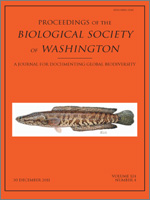Thelytokous parthenogenesis has a distinct advantage for colonization in that single female dispersants can establish new populations. Most sexual nicoletiid (Zygentoma) species tend to have restricted geographical areas. On the contrary, populations of parthenogenetic females of Nicoletia phytophila Gervais, 1844 are cosmopolitan. It has been hypothesized that their global dispersion was caused by recent indirect human action, such as transportation of garden soil. DNA sequences of the 16S rRNA in N. phytophila populations from Mexico, Cuba, Grenadine Islands, and Puerto Rico revealed that on the contrary, they were considerably different, which is more consistent with a divergence origin millions of years ago.
How to translate text using browser tools
1 December 2011
Cosmopolitan dispersion in a parthenogenetic insect (Nicoletia phytophila; Zygentoma): Human facilitated or much older?
Luis Espinasa,
Marlene Dunfee,
Chelsea Lettieri,
Jennifer Walker
ACCESS THE FULL ARTICLE
It is not available for individual sale.
This article is only available to subscribers.
It is not available for individual sale.
It is not available for individual sale.
Baker's law
bristletails
Cubacubaninae





